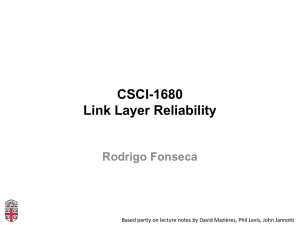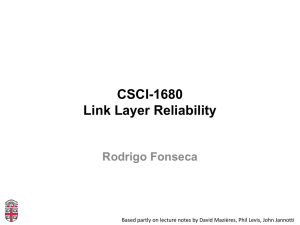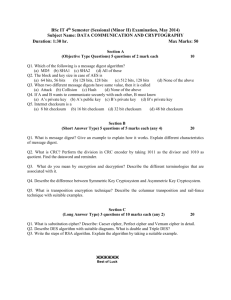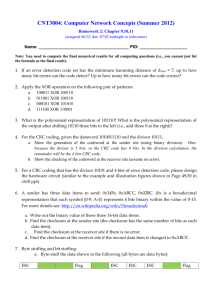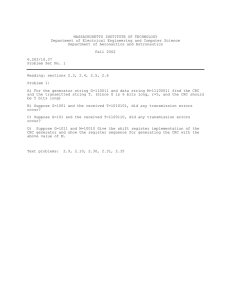L4 - Link Layer
advertisement
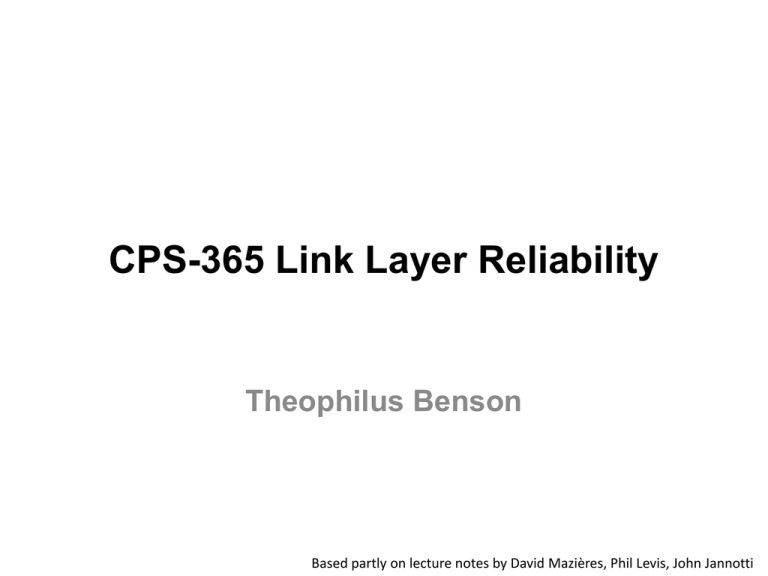
CPS-365 Link Layer Reliability
Theophilus Benson
Based partly on lecture notes by David Mazières, Phil Levis, John Jannotti
• Last time
– Physical layer: encoding, modulation
• Today
– Clarifications
– Link layer framing
– Getting frames across: reliability, performance
Layering + Encapsulation
VIDEO
Application
Application
Transport
Transport
Network
Network
Link
Link
Physical
Physical
Layering + Encapsulation
Application
Application
Transport
VIDEO T
Transport
Network
Network
Link
Link
Physical
Physical
Layering + Encapsulation
Application
Application
Transport
Transport
Network
VIDEO T N
Network
Link
Link
Physical
Physical
Layering + Encapsulation
Application
Application
Transport
Transport
Network
Network
Link
Physical
VIDEO T N L
Link
Physical
Layering + Encapsulation
Application
Application
Transport
Transport
Network
Network
Link
Link
Physical
VIDEO T N L P
Physical
Layering + Encapsulation
Application
Application
Transport
Transport
Network
Network
Link
Link
Physical
VIDEO T N L P
Physical
Layering + Encapsulation
Application
Application
Transport
Transport
Network
Network
Link
Physical
VIDEO T N L
Link
Physical
Layering + Encapsulation
Application
Application
Transport
Transport
Network
VIDEO T N
Network
Link
Link
Physical
Physical
Layering + Encapsulation
Application
Application
Transport
VIDEO T
Transport
Network
Network
Link
Link
Physical
Physical
Layering + Encapsulation
Application
VIDEO
Application
Transport
Transport
Network
Network
Link
Link
Physical
Physical
CPS 365 V. Duke Book Store
Layers, Services, Protocols
Application
Service: user-facing application.
Application-defined messages
Transport
Service: multiplexing applications
Reliable byte stream to other node (TCP),
Unreliable datagram (UDP)
Network
Service: move packets to any other node in the network
IP: Unreliable, best-effort service model
Link
Physical
Service: move frames to other node across link.
May add reliability, medium access control
Service: move bits to other node across link
Framing
• Given a stream of bits, how can we
represent boundaries?
• Break sequence of bits into a frame
• Typically done by network adaptor
Representing Boundaries
Approaches
• Sentinels
• Length counts
• Clock-based
Characteristics
• Bit- or byte oriented
• Fixed or variable length
• Data-dependent or
independent
Sentinel-based Framing
• Byte-oriented protocols (e.g. BISYNC, PPP)
– Place special bytes (SOH, ETX,…) in the beginning,
end of messages
• What if ETX appears in the body?
– Escape ETX byte by prefixing DEL byte
– Escape DEL byte by prefixing DEL byte
– Technique known as character stuffing
Bit-Oriented Protocols
• View message as a stream of bits, not bytes
• Can use sentinel approach as well (e.g.,
HDLC)
– HDLC begin/end sequence 01111110
• Use bit stuffing to escape 01111110
– Always append 0 after five consecutive 1s in data
– After five 1s, receiver uses next two bits to decide if
stuffed, end of frame, or error.
Representing Boundaries
Approaches
• Sentinels
• Length counts
• Clock-based
Characteristics
• Bit- or byte oriented
• Fixed or variable length
• Data-dependent or
independent
Length-based Framing
• Drawback of sentinel techniques
– Length of frame depends on data
• Alternative: put length in header (e.g.,
DDCMP)
• Danger: Framing Errors
– What if high bit of counter gets corrupted?
– Adds 8K to length of frame, may lose many frames
– CRC checksum helps detect error
Representing Boundaries
Approaches
• Sentinels
• Length counts
• Clock-based
Characteristics
• Bit- or byte oriented
• Fixed or variable length
• Data-dependent or
independent
Clock-based Framing
• E.g., SONET (Synchronous Optical
Network)
– Each frame is 125μs long
– Look for header every 125μs
– Encode with NRZ, but first XOR payload with
127-bit string to ensure lots of transitions
Representing Boundaries
Approaches
Characteristics
• Sentinels
• Length counts
• Clock-based
• Bit- or byte oriented
• Fixed or variable length
• Data-dependent or
independent
Error Detection
• Basic idea: use a checksum
– Compute small checksum value, like a hash of
packet
• Good checksum algorithms
– Want several properties, e.g., detect any single-bit
error
– Details in a later lecture
Latency Breakdown
NIC
NIC
Switch
CPU
Switch
NIC
NIC
NIC
Switch
Latency Breakdown
Propagation
Delay
Transmission
Delay
NIC
NIC
Switch
CPU
NIC
NIC
NIC
Queuing
Delay
Switch
Processing
Delay
Switch
Sending Frames Across
Transmission Delay
Latency
Propagation Delay
…
Sending Frames Across
…
Throughput: bits / s
Which matters most, bandwidth or
delay?
Time
• How much data can we send during one
RTT?
• E.g., send request, receive file
• For small transfers, latency more important,
for bulk, throughput more important
Performance Metrics
• Throughput - Number of bits received/unit of
time
– e.g. 10Mbps
• Goodput - Useful bits received per unit of
time
• Latency – How long for message to cross
network
– Process + Queue + Transmit + Propagation
• Jitter – Variation in latency
More on GoodPut
VIDEO T N L P
Useful
bits
Meta-data
If you send 30 Mbps… but every packet contains:
50bits of data and
50bits of header.
What is your GoodPut?
Latency
• Processing
– Per message, small, limits throughput
– e.g. 100Mb ´ pkt ´ B » 8,333pkt /s
or
s
1500B 8b
120μs/pkt
• Queue
– Highly variable, offered load vs outgoing b/w
• Transmission
– Size/Bandwidth
• Propagation
– Distance/Speed of Light
Reliable Delivery
• Several sources of errors in transmission
• Error detection can discard bad frames
• Problem: if bad packets are lost, how can
we ensure reliable delivery?
– Exactly-once semantics = at least once + at most
once
At Least Once Semantics
• How can the sender know packet arrived
at least once?
– Acknowledgments + Timeout
• Stop and Wait Protocol
–
–
–
–
S: Send packet, wait
R: Receive packet, send ACK
S: Receive ACK, send next packet
S: No ACK, timeout and retransmit
Stop and Wait Problems
•
•
•
•
Duplicate data
Duplicate acks
Slow (channel idle most of the time!)
May be difficult to set the timeout value
Duplicate data: adding sequence
numbers
At Most Once Semantics
• How to avoid duplicates?
– Uniquely identify each packet
– Have receiver and sender remember
• Stop and Wait: add 1 bit to the header
– Why is it enough?
Going faster: sliding window protocol
• Still have the problem of keeping pipe full
– Generalize approach with > 1-bit counter
– Allow multiple outstanding (unACKed) frames
– Upper bound on unACKed frames, called
window
How big should the window be?
• How many bytes can we transmit in one RTT?
– BW B/s x RTT s => “Bandwidth-Delay Product”
Maximizing Throughput
• Can view network as a pipe
– For full utilization want bytes in flight ≥ bandwidth ×
delay
– But don’t want to overload the network (future
lectures)
How To Fill The Pipe
• Blast packets into the Network
• What if protocol doesn’t involve bulk
transfer?
– Get throughput through concurrency – service
multiple clients simultaneously
Sliding Window Sender
• Assign sequence number (SeqNum) to each frame
• Maintain three state variables
– send window size (SWS)
– last acknowledgment received (LAR)
– last frame sent (LFS)
• Maintain invariant: LFS – LAR ≤ SWS
• Advance LAR when ACK arrives
• Buffer up to SWS frames
Sliding Window Receiver
• Maintain three state variables:
– receive window size (RWS)
– largest acceptable frame (LAF)
– last frame received (LFR)
• Maintain invariant: LAF – LFR ≤ RWS
• Frame SeqNum arrives:
– if LFR < SeqNum ≤ LAF, accept
– if SeqNum ≤ LFR or SeqNum > LAF, discard
• Send cumulative ACKs
Tuning Send Window
• How big should SWS be?
– “Fill the pipe”
• How big should RWS be?
– 1 ≤ RWS ≤ SWS
• How many distinct sequence numbers
needed?
– SWS can’t be more than half of the space of
valid seq#s.
Example
•
•
•
•
•
SWS = RWS = 5. Are 6 seq #s enough?
Sender sends 0,1,2,3,4
All acks are lost
Sender sends 0,1,2,3,4 again
…
Summary
• Want exactly once
– At least once: acks + timeouts + retransmissions
– At most once: sequence numbers
• Want efficiency
– Sliding window
Error Detection
• Idea: have some codes be invalid
– Must add bits to catch errors in packet
• Sometimes can also correct errors
– If enough redundancy
– Might have to retransmit
• Used in multiple layers
• Three examples today:
– Parity
– Internet Checksum
– CRC
Simplest Schemes
• Repeat frame n times
– Can we detect errors?
– Can we correct errors?
• Voting
– Problem: high redundancy : n
• Example: send each bit 3 times
– Valid codes: 000 111
– Invalid codes : 001 010 011 100 101 110
– Corrections : 0 0 1
0 1 1
Parity
• Add a parity bit to the end of a word
• Example with 2 bits:
– Valid: 000 011 011 110
– Invalid: 001 010 010 111
– Can we correct?
• Can detect odd number of bit errors
– No correction
In general
• Hamming distance: number of bits that
are different
– E.g.: HD (00001010, 01000110) = 3
• If min HD between valid codewords is d:
– Can detect d-1 bit error
– Can correct ⌊(d-1)/2⌋ bit errors
• What is d for parity and 3-voting?
2-D Parity
• Add 1 parity bit for each 7 bits
• Add 1 parity bit for each bit position across
the frame)
– Can correct single-bit errors
– Can detect 2- and 3-bit errors, most 4-bit errors
• Find a 4-bit error that can’t be corrected
IP Checksum
• Fixed-length code
– n-bit code should capture all but 2-n fraction of errors
• Why?
– Trick is to make sure that includes all common errors
• IP Checksum is an example
– 1’s complement of 1’s complement sum of every 2
bytes
uint16 cksum(uint16 *buf, int count) {
uint32 sum = 0;
while (count--)
if ((sum += *buf++) & 0xffff0000) // carry
sum = (sum & 0xffff) + 1;
return ~(sum & 0xffff);
}
How good is it?
• 16 bits not very long: misses how many
errors?
– 1 in 216, or 1 in 64K errors
• Checksum does catch all 1-bit errors
• But not all 2-bit errors
– E.g., increment word ending in 0, decrement one
ending in 1
• Checksum also optional in UDP
– All 0s means no checksums calculated
– If checksum word gets wiped to 0 as part of
error, bad news
From rfc791 (IP)
“This is a simple to compute checksum and
experimental evidence indicates it is
adequate, but it is provisional and may be
replaced by a CRC procedure, depending on
further experience.”
CRC – Error Detection with
Polynomials
• Goal: maximize protection, minimize bits
• Consider message to be a polynomial in
Z2[x]
– Each bit is one coefficient
– E.g., message 10101001 -> m(x) = x7 + x5+ x3 + 1
• Can reduce one polynomial modulo another
– Let n(x) = m(x)x3. Let C(x) = x3 + x2 + 1.
– n(x) “mod” C(x) : r(x)
– Find q(x) and r(x) s.t. n(x) = q(x)C(x) + r(x) and
degree of r(x) < degree of C(x)
– Analogous to taking 11 mod 5 = 1
Polynomial Division Example
• Just long division, but addition/subtraction is XOR
CRC
• Select a divisor polynomial C(x), degree k
– C(x) should be irreducible – not expressible as a
product of two lower-degree polynomials in Z2[x]
• Add k bits to message
– Let n(x) = m(x)xk (add k 0’s to m)
– Compute r(x) = n(x) mod C(x)
– Compute n(x) = n(x) – r(x) (will be divisible by C(x))
(subtraction is XOR, just set k lowest bits to r(x)!)
• Checking CRC is easy
– Reduce message by C(x), make sure remainder is 0
Why is this good?
• Suppose you send m(x), recipient gets m’(x)
– E(x) = m’(x) – m(x) (all the incorrect bits)
– If CRC passes, C(x) divides m’(x)
– Therefore, C(x) must divide E(x)
• Choose C(x) that doesn’t divide any common
errors!
– All single-bit errors caught if xk, x0 coefficients in C(x)
are 1
– All 2-bit errors caught if at least 3 terms in C(x)
– Any odd number of errors if last two terms (x + 1)
– Any error burst less than length k caught
Common CRC Polynomials
• Polynomials not trivial to find
– Some studies used (almost) exhaustive search
• CRC-8: x8 + x2 + x1 + 1
• CRC-16: x16 + x15 + x2 + 1
• CRC-32: x32 + x26 + x23 + x22 + x16 + x12 +
x11 + x10 + x8 + x7 + x5 + x4 + x2 + x1 + 1
• CRC easily computable in hardware
An alternative for reliability
• Erasure coding
– Assume you can detect errors
– Code is designed to tolerate entire missing frames
• Collisions, noise, drops because of bit errors
– Forward error correction
• Examples: Reed-Solomon codes, LT Codes,
Raptor Codes
• Property:
– From K source frames, produce B > K encoded
frames
– Receiver can reconstruct source with any K’ frames,
with K’ slightly larger than K
– Some codes can make B as large as needed, on the
fly
LT Codes
• Luby Transform Codes
– Michael Luby, circa 1998
• Encoder: repeat B times
1. Pick a degree d
2. Randomly select d source blocks. Encoded
block tn= XOR or selected blocks
LT Decoder
• Find an encoded block tn with d=1
• Set sn = tn
• For all other blocks tn’ that include sn ,
set tn’=tn’ XOR sn
• Delete sn from all encoding lists
• Finish if
1. You decode all source blocks, or
2. You run out out blocks of degree 1
Next class
• Link Layer II
– Ethernet: dominant link layer technology
• Framing, MAC, Addressing
– Switching
